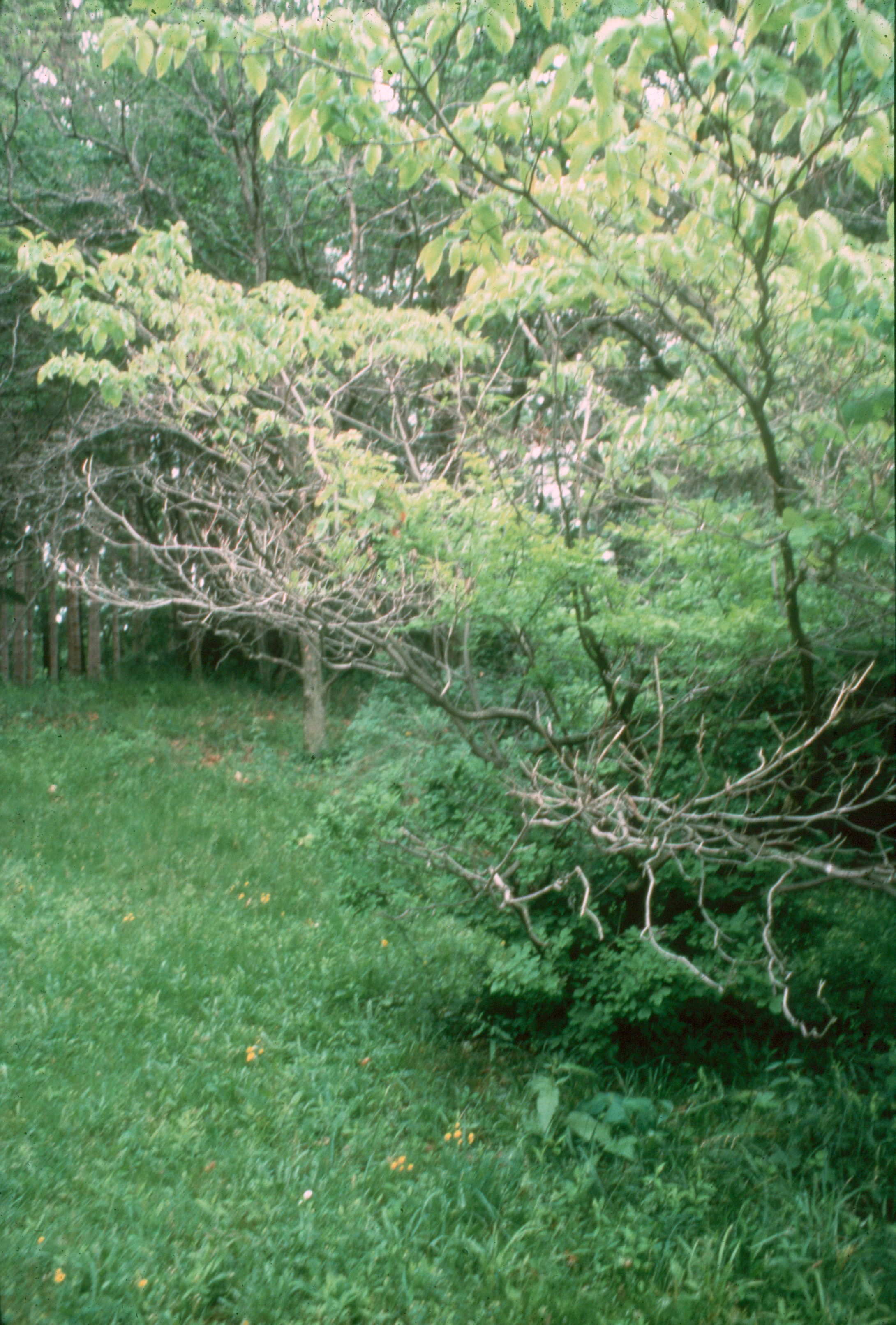Dogwood Anthracnose
P086 (1/06)
By Dr. Sharon M. Douglas
Department of Plant Pathology and Ecology
The Connecticut Agricultural Experiment Station
123 Huntington Street
P. O. Box 1106
New Haven, CT 06504-1106
Telephone: (203) 974-8601 Fax: (203) 974-8502
Email: Sharon.Douglas@po.state.ct.us
Dogwood anthracnose is considered the most serious disease of
flowering dogwood (Cornus florida) in Connecticut and the Eastern
Seaboard. It is also an important disease of Pacific Dogwood (Cornus
nuttallii) in the West. The causal agent is the fungus Discula
destructiva, and as the name suggests, this pathogen is highly destructive.
It is believed that the fungus was probably simultaneously introduced into the
East and West Coasts of the United States in the mid-1970s. Since its
introduction, dogwood anthracnose has resulted in the death of many dogwoods in
forests, woodlots, and landscapes.
SYMPTOMS AND DISEASE DEVELOPMENT:
Initial foliar symptoms develop in May and June as brown
spots up to ¼ inch in diameter that are visible on both the upper and lower leaf
surfaces (Figure 1). These spots can be circular or irregular in shape and
frequently develop distinctive smoky, purple-brown margins (Figure 2).


Figure 1. Necrotic spots on leaves. Figure 2. Smoky,
purple-brown rings on foliar lesions.
The flower bracts are also susceptible to infection and
develop reddish or brownish spots or blotches. These are most prevalent when wet
conditions occur during flowering.
Under certain conditions, pinpoint, brownish-black fruiting structures can be
seen in the centers of the foliar spots or lesions. Spots on the leaves usually
become so numerous that they coalesce, which results in the development of
large, dead areas on the leaves. When entire leaves become necrotic, they
usually droop and rather than falling off, they remain on the tree throughout
the fall and into the winter. The persistence of infected leaves on the tree
during winter is a distinctive characteristic and can help in diagnosis. The
presence of infected leaves on the tree also serves as an important source of
overwintering inoculum, since fungal spores capable of initiating new infections
in spring are produced on these leaves.
When the whole leaf becomes infected, the fungus grows into the petiole and then
into the twig where it causes cankers. Cankers are often tan, slightly sunken,
elliptical areas of bark and are readily distinguished from surrounding healthy
bark. The fungus can also directly infect shoots

Figure 3. Progressive dieback of branches up the tree.
during spring and fall. These infections develop into very
small cankers. If left unchecked, these cankers increase in size and eventually
girdle the affected tissues (e.g., twigs, stems, branches, or the main trunk).
Symptoms and branch dieback typically begin on the lower limbs and move
progressively up the tree (Figure 3). This pattern of dieback appears to be
associated with poor air circulation in the lower canopy, which results in
tissues staying wet for longer periods of time. This makes them more susceptible
to infection. Some trees attempt to compensate for the loss of limbs by sending
out sprouts from the trunk (epicormic sprouts) but these sprouts are highly
susceptible to infection. Sprout infections usually spread quickly to the trunk
and cause severe cankers and splits in the bark. These cankers readily develop
into tree-killing cankers.
Dogwood anthracnose is more aggressive on trees that have been predisposed or
weakened by environmental and cultural factors. Among some of the more common
predisposing factors are drought stress, poor site selection (e.g., full sun,
windy or open area, or thin or rocky soil), mechanical injury (e.g., damage from
string trimmers and lawn mowers), and soil compaction.
DISEASE MANAGEMENT STRATEGIES:
The effects of dogwood anthracnose can be minimized by following an
integrated approach toward managing the disease.
-
Rake and remove fallen leaves to remove important sources of overwintering inoculum.
-
Prune and remove cankered limbs and dead wood. This helps to reduce the ability of the fungus to grow into the main trunk where girdling, tree-killing cankers can develop.
-
Maintain tree vigor by following sound cultural practices. It is especially important to avoid drought stress so watering the tree during periods of low rainfall is essential. Mulching is also helpful since it helps maintain soil moisture, moderate soil temperatures, and minimize chances for mechanical injuries.
-
Provide adequate spacing for good air circulation. Since the fungus requires free water on plant surfaces in order to infect, any practices that reduce periods of wetness can help to minimize chances for infection.
-
Control insects and avoid unnecessary mechanical injuries.
-
Plant resistant species or cultivars. Although Cornus kousa (Kousa Dogwood) is less susceptible to infection than C. florida (Flowering Dogwood), it can become infected in years when there is heavy infection pressure and favorable weather for disease development. Breeding programs that have made crosses between C. florida and C. kousa have yielded promising cultivars such as the 'Stellar' Hybrid series, 'Aurora,' 'Celestial,' 'Constellation,' 'Ruth Ellen,' 'Stardust,' and 'Stellar Pink.'
-
Fungicides are another component of disease management. Applications can be made at budbreak, when the bracts fall, and 4 weeks later. A late-summer fungicide application when fruit and leaves begin to color has also been found to be helpful. Among the compounds registered for homeowner use in Connecticut are chlorothalonil, copper hydroxide, mancozeb, and thiophanate-methyl. Consult the label for dosage rates and safety precautions.

